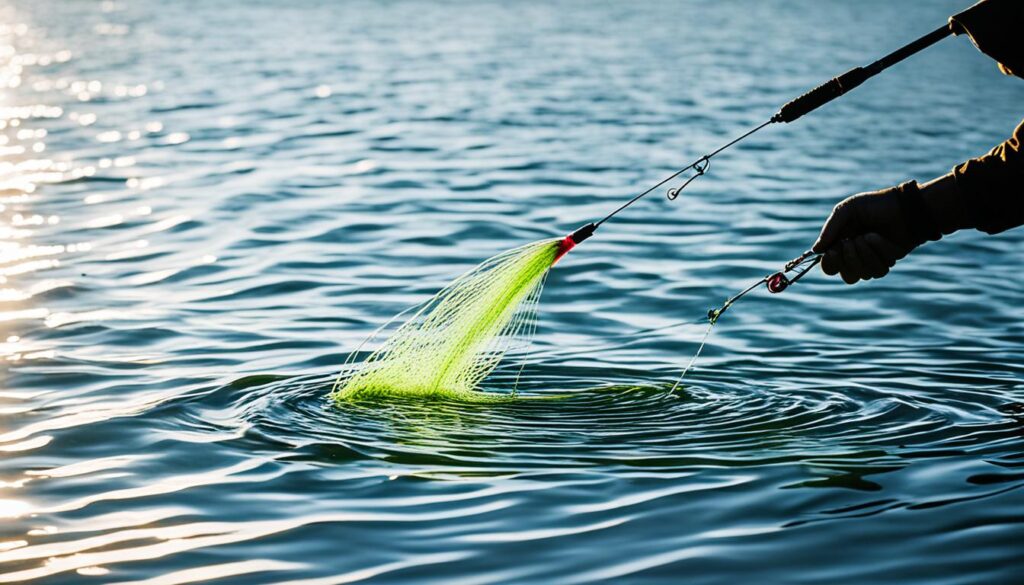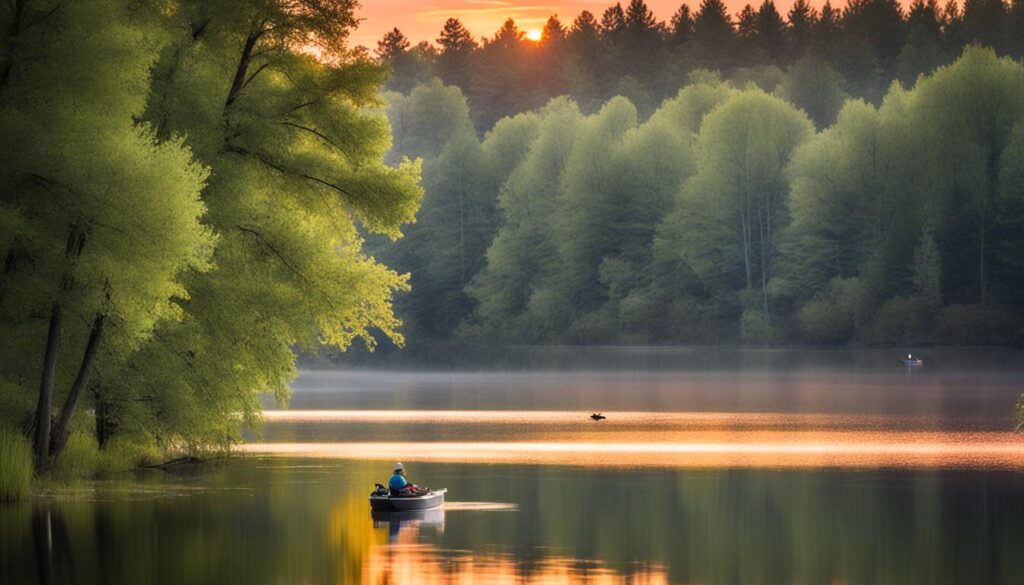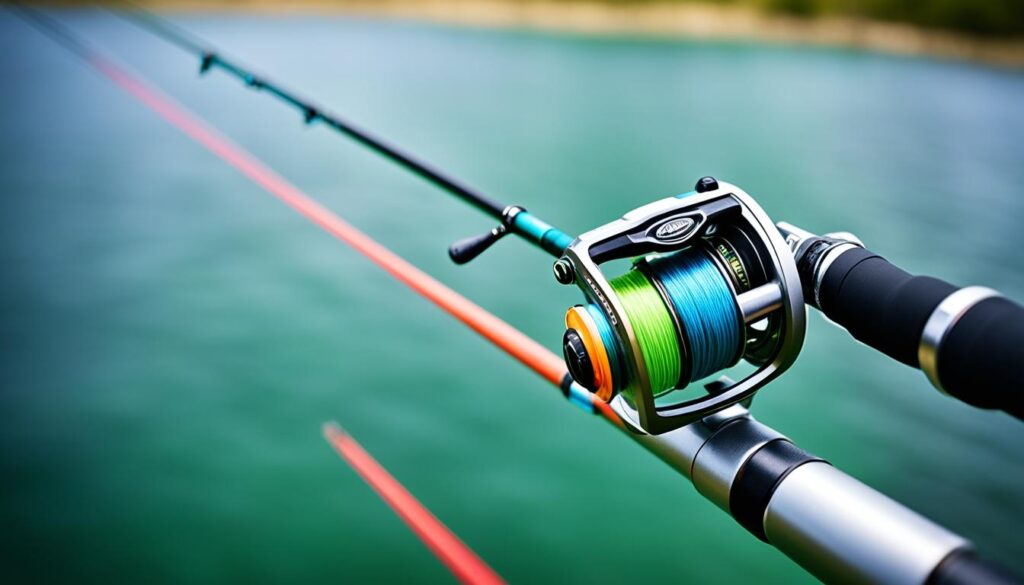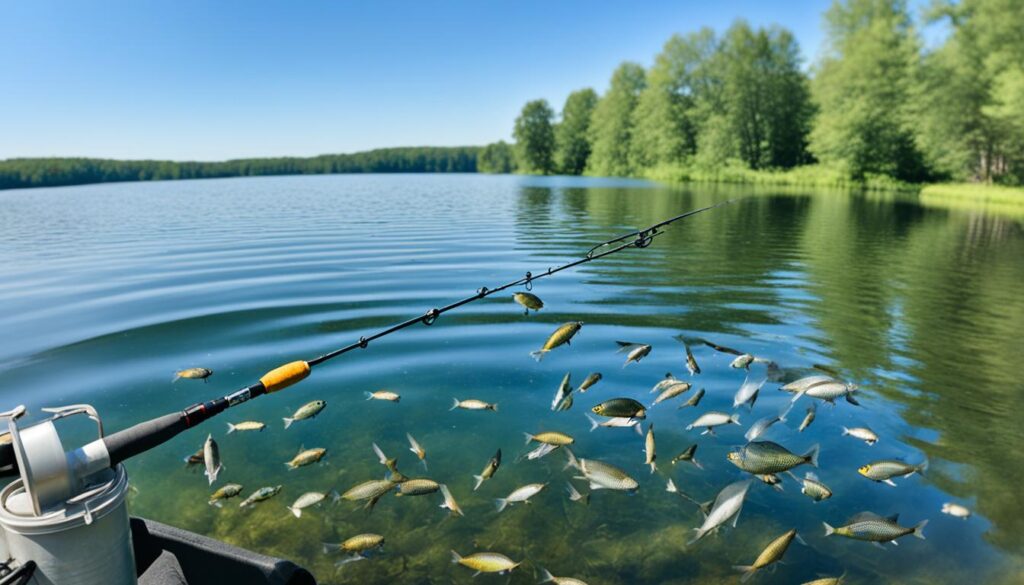Fishing for bluegill is exciting and can bring back your childhood memories. It’s a perfect sport for both beginners and seasoned anglers. You can catch them without needing fancy gear or fishing expertise.
Bluegill fish are a favorite due to their delicious meat and energetic nature. This guide will help you start quickly and move on to big catches. You might even find yourself reeling in a record-breaker.
Key Takeaways:
- Bluegill fishing is an accessible and enjoyable activity for anglers of all levels.
- Bluegill is abundant across the United States and found in various freshwater habitats.
- Simple tackle and bait fishing techniques are effective for catching bluegill.
- Targeting specific fishing spots and understanding seasonal patterns can improve your bluegill catches
- Catch and release practices help maintain healthy bluegill populations
The Joy of Bluegill Fishing
Bluegill fishing is fun and easy for people of all ages and abilities. They are plentiful and eager to bite. Bluegills are great for beginners and pros because of their lively fight. This makes them a top choice for anyone wanting to try freshwater fishing. You only need simple gear and catch many, which is exciting for new and experienced anglers.
Fun for All Ages and Skill Levels
Bluegill is a joy to catch, whether you’re new or a pro at panfish tactics. They eat various baits, making them perfect for everyone. Feeling a bluegill bite and pulling it in is thrilling, no matter your skill level.
Introducing New Anglers to the Sport
Bluegill is perfect for introducing kids to fishing. With essential equipment and many catches, kids often get hooked. Seeing a child catch their first bluegill is heartwarming and can lead to a lifelong love of fishing for them.

Where to Find Bluegill
Bluegill is easy to find all around the United States except Alaska. Anglers can enjoy catching them in any region. They are usually in calm waters, like lakes, ponds, or slow rivers. You’ll find them near things like docks, fallen trees, and plants that grow in water.
In the spring, they move to shallow areas to lay eggs. When the weather gets warmer, they go into deeper water. In the fall, they come closer to the shore again.
Prevalence Across the United States
You can find bluegill in almost every state in the country. This makes them a beloved catch for people who love fishing. They live in various places, from the East Coast to the West Coast.
Preferred Habitats and Locations
Bluegills like peaceful waters, such as lakes, ponds, and slow rivers. They hang out near things in the water, like trees, plants under the water, and docks. These places give them shade, protection, and food.
If you want to catch bluegill often, look for these kinds of spots all year round.

Essential Tackle for Bluegill Angling
Fishing tackle for bluegill is pretty simple. It would help to have a hook, small bobber, split shot, and live bait like worms or crickets. Start by attaching a size 6 Aberdeen hook to a 4-pound monofilament line. Then, use light or ultralight gear for your rod and reel. With this setup, you can fish from the surface to about 10 feet deep.
Simple Rigs and Setups
A drop shot rig is another excellent option. It includes a tiny bell sinker and live bait suitable for fishing on the bottom—many anglers also like using tiny crankbaits and jigs under a bobber or cast-and-retrieve.
Ultralight and Spinning Combos
Using light tackle and gear makes bluegill fishing more fun and challenging. Following a catch-and-release approach also helps keep bluegill populations healthy for the long term.
HOW TO CATCH BLUEGILL | A SIMPLE GUIDE TO BLUEGILL FISHING
Targeting Prime Bluegill Spots
First, find areas where bluegill might hide. Look for calm spots with many hiding places under the water. Then, cast your bait near docks and fallen trees. Reel it in slowly to cover all depths and areas.
Notice where you start getting bites. Stay focused there because bluegill usually moves and eats in groups.
Fan Casting and Slow Retrieves
When you’re after bluegill, slow and gently catch the fish. Please keep your movements light to feel the subtle tugs of bluegill bites. Cast broadly and pull in your line slowly to tempt even the pickiest bluegill.
BEST TIMES TO FISH FOR BLUEGILL
Fishing for bluegill can be good all year round. However, some times are better than others. In the spring, bluegill is active when the water gets warmer and reaches the 70s. They like to stay in shallow water, making nests and caring for their eggs. Anglers can see and target these nests with small lures or live bait.
Spring Spawning Season
Spring is a great time to catch bluegill. They gather in shallow waters to make nests and guard their eggs. Because they are very protective now, they are more likely to attack bait or lures. Could you look for these circular nests and place your bait or lures near them to catch male bluegill?
Winter Patterns and Deep Water Tactics
In winter, bluegill gathers in deep water near brush piles. Use a fish finder to discover where they are, and then fish straight down with small jigs or live bait. Even though the water is cold, bluegill will still go for your bait or lures if presented well.
TOP BAITS FOR BLUEGILL FISHING
Bluegill eats many things and loves live bait. Red worms, crickets, larvae, and mealworms work well. Their smell and movement attract bluegill and make them bite easily.
Live Baits: Worms, Crickets, and More
Bait fishing for bluegill is best with live bait like red worms and crickets. Bluegill can’t resist the natural scent and the way these baits move. Try maggots and mealworms, too, as they also work great.
Artificial Lures: Tiny Crankbaits and Jigs
Are you using ultralight gear and catch and release techniques? Small artificial lures are your friends. Use tiny crankbaits, in-line spinners, and small jigs with soft plastic. It would be best if you made the bait smaller for their mouths. A gentle approach is crucial for getting bluegill to bite.
GEAR AND TACKLE CONSIDERATIONS
Bluegills are small, so use light, finesse tackle for these panfish. A 2—to 4-pound test line with size 6 or 8 hooks is perfect. It’s the right mix of strength and subtlety for ultralight gear and catch-and-release fishing.
Light Line and Small Hooks
Stick to ultralight or light-action gear for bluegill. With this gear, you can easily cast the small lures they love. It’s fun and challenging because you must be gentle to feel and catch their soft bites.
Fly Fishing for Bluegill
Fly fishing can be great for bluegill. Use tiny popper flies or sponge spiders. Cast these flies or float them under a clear bobber. Their movement and look attract bluegill, making fishing even more dynamic.
BLUEGILL FISHING HOTSPOTS
Bluegills are often found in freshwater habitats like ponds and small lakes. These areas are great for fishing because they are more relaxed. You can find many healthy, big bluegills in places many overlook. This makes fishing more fun and allows you to catch some big fish.
Ponds and Lightly Fished Waters
Big lakes have bluegills, too, but the best spots might be smaller ponds or private lakes. These places are less crowded with other anglers so that the bluegill can grow big. Look for ponds hidden by trees or those that are challenging to reach. They can be unique spots full of fish for those eager to explore.
Structure and Cover Attractants
Bluegills love places where they can hide and find food. Fallen trees, logs under the water, plants, and docks are perfect for this.
Focusing on these spots can help you find more fish. It doesn’t matter if you fish from the shore or a boat. You’ll likely catch more if you aim for where the bluegill hides.
IDENTIFYING AND CATCHING BLUEGILL
Bluegill is easy to spot because of its unique look. They’re shaped like an oval and are usually dark green or blue on top. This color fades into a bright yellow or orange on their belly.
Look for a dark spot by their dorsal fin and a dark “ear” shape near their gill plate. These markings help you know it’s a bluegill.
Physical Characteristics and Markings
Learning about a bluegill‘s looks can make fishing for them much more accessible. They stand out thanks to their special colors and marks, making picking the right fish for catching more fun.
State Regulations and Records Catches
Make sure you know your state’s fishing rules before you start. Rules like how many bluegills you can catch in a day are essential. You must follow these laws. If you see a big bluegill, it could be a record-breaker.
Big bluegills can weigh over 4 pounds, but it’s crucial to fish responsibly. This helps keep bluegill numbers up for others to enjoy.
THE VERSATILITY OF BLUEGILL FISHING
Bluegill is excellent for all skill levels. They’re easy to catch, and there’s lots of them. That makes them perfect for beginners. But they’re also fun for those who love a challenge with their large size.
A Beginner-Friendly Target Species
Bluegill is a top pick for starting anglers, including kids. With essential gear and lots of bites, they get you hooked fast. It’s a great way to start a fun and rewarding hobby.
Year-Round Opportunities
Fishing for bluegill is good all year, and many techniques work. You can use anything from worms to light equipment. So, it’s a go-to choice for anyone wanting to fish, whether they’re just starting or a seasoned pro.
SECRETS TO BLUEGILL FISHING SUCCESS
Finding those prized bluegill is easier than it seems. You need to know where they hide, pick the right gear, and learn about the seasons. Look for them in shallow waters with lots of hiding spots and use bait that looks natural.
Understanding the basics of bluegill fishing is crucial. Knowing how to fish will up your chances, whether you’re just starting or have fished for years. It’s all about learning the right spots and using the right gear. Make sure to throw back smaller fish to keep their populations healthy.
With a good plan and a little skill, you can catch bluegill at any time of the year. Focus on what works best, and you will have more successful fishing adventures.
You can enjoy this rewarding pastime by knowing the best baits for bluegill fishing, understanding their behavior, and having the right gear. Whether you prefer live bait or artificial lures, there’s something irresistible about the challenge of hooking these vibrant freshwater fish. So, grab your gear, head to your favorite spot, and let the bluegill fishing adventure begin!

FAQ
What makes bluegill an appealing target for anglers?
Bluegill are all about fun. They bring action and a chance to feel young again, even as an adult. Their delicious meat and lively fights attract anglers of every age and skill.
How are bluegill a great way to introduce new anglers to fishing?
They’re perfect for beginners because they don’t need fancy catching gear. Bluegill are everywhere, always ready to bite, and put up a good fight. This makes them great for anyone looking to start fishing or those with experience.
Where can you find bluegill across the United States?
Bluegill can be caught all over the U.S., except for Alaska. You can find them in many places, making them a popular catch. Some spots even offer really big ones to reel in.
What kind of tackle is recommended for bluegill fishing?
Fishing for bluegill is simple. You only need a hook, split shot, small bobber, and some live bait like worms. Use ultralight or light-action gear to cast what bluegill like.
What are some effective techniques for catching bluegill?
One good method is to use live bait underand cast near where they might hide. This is a classic and often successful method. Or, try using small crankbaits and jigs and reeling a small bobber them in slowly to get their attention.
When are the best times of year to target bluegill?
Spring, when the water warms up, is prime bluegill season. They come close to shore to lay eggs and protect their nests. In winter, look for them deep in the water close to structures like brush piles.
What are some of the top baits for catching bluegill?
For live bait, red worms, crickets, and the like work well with bluegill. You can also try tiny crankbaits and jigs as lures, they can be just as effective.
What are some key considerations for bluegill fishing gear?
Use 2- to 4-pound test line and small hooks for the best results. The right gear lets you cast the small lures and baits bluegill go for. For fly fishing, small poppers and sponge spiders are a good choice.
Where are the best places to find bluegill?
Finding bluegill is easier in quiet ponds and small lakes. They often have lots of fish that aren’t used to being caught. Look for them near trees, plants, and docks.
How can you identify and properly handle bluegill?
Bluegill stand out with their oval shape, dark top, and colorful belly. Look for a dark spot near the dorsal fin, and a dark “ear” by the gills. Always handle them with care if you’re not keeping them, to protect the bluegill population.
